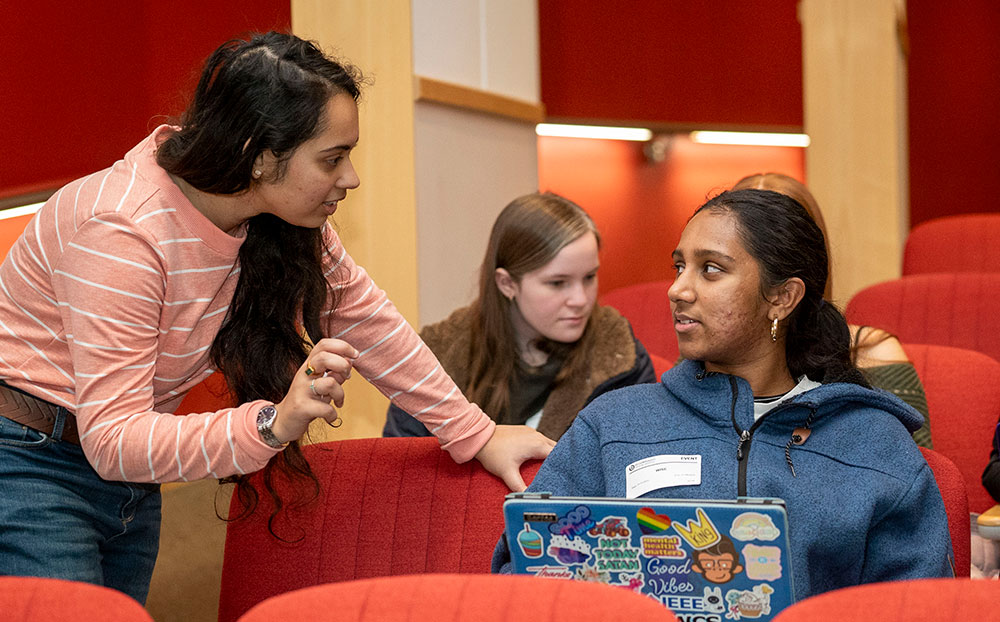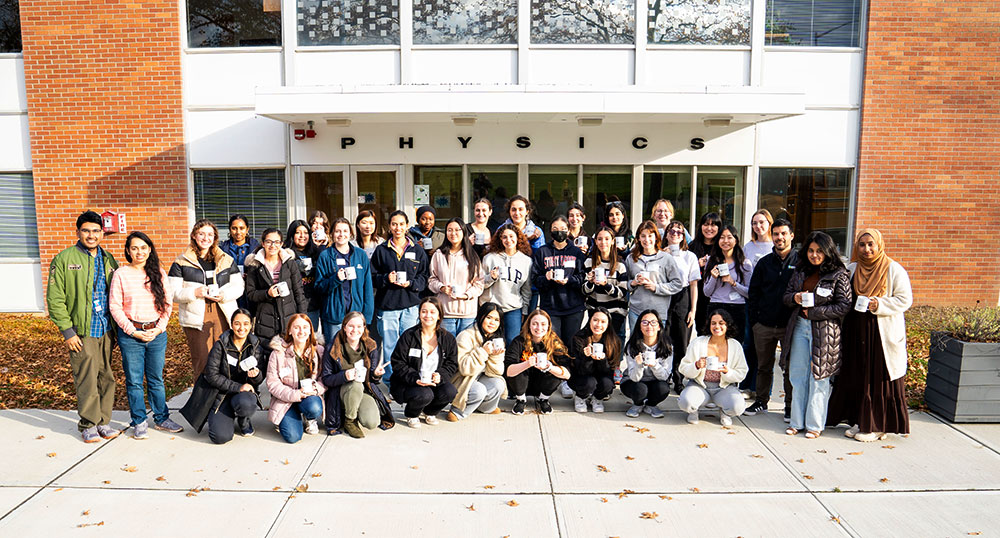Empowering Women to Explore Nuclear Physics
Stony Brook students from the Women in Science and Engineering program got a glimpse into life as a scientist while exploring theoretical and applied nuclear physics
March 29, 2024
 enlarge
enlarge
Shohini Bhattacharya (left) guided students from Stony Brook University's Women in Science and Engineering program through a computer exercise using simulated data from the future Electron-Ion Collider. (David Rahner/Brookhaven National Laboratory)
“What do you think of when I say nuclear physics?” Shohini Bhattacharya asked 35 college-aged women. It was early one Saturday morning at the U.S. Department of Energy’s (DOE) Brookhaven National Laboratory. Bhattacharya, who was a research associate in the RIKEN BNL Research Center and the Nuclear Theory Group of Brookhaven’s Physics Department at the time and is currently a Distinguished Oppenheimer Fellow at DOE’s Los Alamos National Laboratory, was curious to see what a group of students from Stony Brook University’s (SBU) Women in Science and Engineering (WISE) program knew about a field that spans scales from the tiniest building blocks of matter to the stars and galaxies that make up the cosmos.
“The Oppenheimer movie,” replied one student.
“Energy and weapons,” responded another.
Bhattacharya recognized that these were relevant and appropriate responses from her audience, but she was eager to show the group that there is so much more to the field.
“We are working to unravel nature's blueprints by revealing the intricacies within the fundamental building blocks of matter,” Bhattacharya explained.
As part of an ongoing collaboration between Brookhaven Lab and SBU, WISE students spent two Saturdays at Brookhaven Lab completing hands-on activities with scientists from the Physics Department and the Nuclear Science and Technology Department. The students also engaged in conversations with scientists about the passions, triumphs, and difficulties that come with a career in STEM.
On the first Saturday with Bhattacharya, students gained insight into the fundamental questions of nuclear physics and the life of a theoretical nuclear physicist — someone who employs mathematical tools to predict nuclear reactions and unveil patterns in experimental data.
Then, a week later, the students explored the engineering applications of nuclear physics with Andrea Mattera, an associate physicist from the National Nuclear Data Center (NNDC), which is part of the Nuclear Science and Technology Department at Brookhaven. Mattera studies the products of reactions, like nuclear fission, to better understand how they affect the operation of nuclear reactors. He then catalogs these properties and shares them with members of the broader nuclear physics community who are working on applications of nuclear science in medicine, energy, and national security.
“Events like these are excellent opportunities to address some commonly held prejudices and preconceptions about radioactivity and nuclear science,” Mattera said. “But at the end of the day, we volunteer because we love our careers. Getting to share our work with students is just as meaningful for us as it is for them.”
 enlarge
enlarge
A group of students from Stony Brook University's Women in Science and Engineering program spent two Saturdays with scientists from Brookhaven National Laboratory. On the first Saturday, Shohini Bhattacharya (middle row, second from left) introduced the students to theoretical nuclear physics. On the second Saturday, Andrea Mattera (middle row, third from right) organized scavenger hunts that encouraged students to explore applications of nuclear physics, including work done at the National Nuclear Data Center. (David Rahner/Brookhaven National Laboratory)
Hands-on science
When most students learn about the “building blocks” of matter, they are taught about atoms that consist of a nucleus and the surrounding electrons. The nucleus can be broken down further into protons and neutrons, but these are often the smallest bits that come to their minds.
The truth of the matter is that a microcosm made up of quarks and gluons lies within each proton and neutron. As a theoretical physicist, Bhattacharya uses mathematical tools to make predictions about this microcosm, such as how quarks and gluons give rise to the overall properties of protons. But these fundamental building blocks were new to many of the WISE students, most of whom were pursuing a STEM discipline unrelated to physics.
Bhattacharya was eager for the students to step into the shoes of a theoretical physicist. But first, she wanted to familiarize the attendees with fundamental particles and the theory of the strong nuclear force, which holds these building blocks together in all the visible matter of the universe. This theory, known as quantum chromodynamics, includes some of the calculations that Bhattacharya uses to tackle complex nuclear physics problems.
With this background, and Bhattacharya’s expert guidance, the students dove into simulated data from the future Electron-Ion Collider (EIC). The EIC will be a particle accelerator at Brookhaven that collides two beams — one consisting of polarized electrons and the other of polarized protons or other atomic nuclei. These collisions will enable electrons to “shine light” onto protons and atomic nuclei, so that physicists can discern the intricate distributions of quarks and gluons within these composite particles and ultimately gain insight into their overall properties. Bhattacharya generated a set of simulated experimental data, like that which will be collected at the EIC, so that students could engage with “real-world” data and better understand what physicists can infer from such data.
“In college courses, the students are often provided with perfect data sets that don’t reflect potential experimental uncertainties, but this is not the case when conducting research,” Bhattacharya explained. “I felt it was crucial for the students to understand that experimental physicists meticulously account for such uncertainties when collecting data. Then, as theorists, it is imperative for us to acknowledge and comprehend how these experimental uncertainties influence our predictions — and how our predictions are tested by experiments.
“Engaging with simulated data that mirrors the anticipated EIC snapshots offered students a glimpse into how this cutting-edge nuclear physics machine could unveil inherent mysteries within our universe,” she added.
With a day of theoretical nuclear physics under their belts, the WISE students were ready to dive into applications of nuclear physics with NNDC scientists. These scientists collect and evaluate nuclear data — including details of nuclear structure, nuclear decay, and nuclear reactions — and then make it accessible to professionals around the world. Specifically, scientists conducting nuclear reactor research or medical professionals working with radiopharmaceuticals to diagnose or treat illnesses may access the data to ensure the safety of everyone involved.
“We wanted to show the students that talking about radioactivity should not be tricky,” explained Mattera. “Our efforts to better understand radioactivity and its sources are necessary for society.” National security experts, for example, use information from NNDC databases to identify if nuclear material is present where it should not be, like in airports. In other cases, medical physicists use the databases to establish effective doses for cancer treatments.
“Most importantly, we help figure out how to work with radiation and radioactive materials safely and effectively,” Mattera added.
As a fun challenge, Mattera and his colleagues set up a scavenger hunt with safe, everyday objects that emit low doses of radioactivity — like rocks and table salt substitutes that can be purchased at the grocery store — which are harmless to the human body.
Assisted by interns from DOE’s Science Undergraduate Laboratory Internships (SULI) at Brookhaven Lab, the WISE students set off with germanium detectors, which can detect the gamma rays emitted by radioactive isotopes. These radioactive signals are particularly important because every isotope can be characterized and identified based on a unique gamma ray pattern, or “fingerprint.” Part of NNDC’s role is to develop databases that facilitate the identification and characterization of these fingerprints. Then, professionals can use the databases to locate, identify, and assess radioactive sources for potential benefits or hazards.
“The detectors are extremely sensitive, so even potassium chloride from the grocery store can serve as a radioactive source,” Mattera explained.
The detectors, which were provided by the National Nuclear Security Administration’s regional Radiological Assistance Program at Brookhaven Lab, helped students locate the radioactive sources. By analyzing the gamma rays emitted from the sources and conferring with the NNDC databases, the students identified each radioactive source, “just like scientists would,” Mattera said.
The students also measured radiation levels with a Geiger counter, which makes a clicking sound when it detects radioactive particles. Though these detectors cannot identify radioisotopes via gamma-ray “fingerprints,” the students could use them to observe the attenuation of radioactivity with distance by taking measurements at different distances from the radioactive sources.
“This exercise doubled as a radiation safety lesson,” Mattera explained, elaborating the guiding principle of radiation safety: keeping exposures as low as reasonably achievable, or ALARA. Mattera and his colleagues also reviewed protective measures, like minimization of exposure time, maximization of one’s distance from the source, and using materials like lead as shielding.
Part of a larger community
Brookhaven scientists also took time to share their stories with the students and opened the floor to questions.
Haiyan Gao, the Lab’s associate laboratory director for Nuclear and Particle Physics, described challenges she and other women faced while pursuing a career in physics. Notably, she shared photos of her graduate school days when she was the only graduate student in her program who was also a mother.
“As a postdoc, I was deeply moved by Haiyan's open discussions about sensitive and fundamental issues that women working in STEM encounter, such as their underrepresentation and the challenges of balancing motherhood with graduate studies and research,” Bhattacharya said.
Hong Ma, chair of Brookhaven’s Physics Department, emphasized the importance of students taking advantage of any hands-on opportunities — like these collaborative events with SBU or internships at Brookhaven.
Bhattacharya and Mattera shared their own experiences as early-career scientists.
“I have witnessed the challenges that young women often face in pursuing STEM, particularly the pervasive feeling of not belonging,” Bhattacharya said. “So, I was driven to give these students the confidence and motivation to continue their STEM journeys.”
Bhattacharya was especially surprised by the number of students asking about how she came to realize that she wanted to pursue a career in nuclear physics.
“My desire to understand the universe fueled my fascination with physics,” Bhattacharya explained. “I am fortunate to have developed a passion for this field, as it is the language of nature. But this curiosity is not shared by everyone, and that is why we must provide students with a broad spectrum of experiences and opportunities. We cannot expect the next generation to discern their passions without our efforts to cultivate curiosity and spark interest.”
Mattera added, “Many students have horrible experiences with physics or math courses in high school. But events like this give us a chance to show them that these fields are fun, interesting, and most importantly, attainable.
“It is an honor to be a part of bringing the next generation of scientists to Brookhaven,” Mattera said. “I have several colleagues who were introduced to Brookhaven Lab through a school program or an internship, and they ended up staying at the Lab for years, if not decades. I hope to have the same impact on these students and see many of them return to Brookhaven in the future.”
Brookhaven National Laboratory is supported by the Office of Science of the U.S. Department of Energy. The Office of Science is the single largest supporter of basic research in the physical sciences in the United States and is working to address some of the most pressing challenges of our time. For more information, visit science.energy.gov.
Follow @BrookhavenLab on social media. Find us on Instagram, LinkedIn, X, and Facebook.
2024-21624 | INT/EXT | Newsroom









